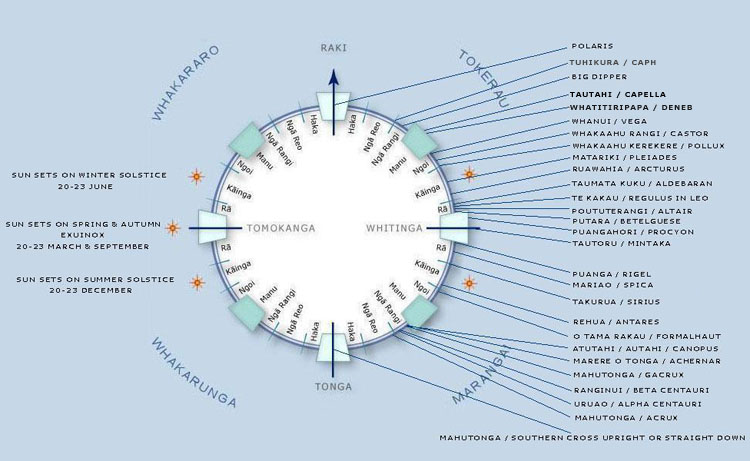

![]()
The following diagram shows some of the brightest stars used for navigating throughout Polynesia and which 'whare' or 'house' they rise in the east (and therefore set in the west). Note that the star compass shows us the declination of stars, so this is where they will rise and set on the celestial equator, this varies slightly for our horizon here in Aotearoa as our latitude is roughly -36°S below the celestial equator and we can not see some of the Northern stars, also the more Southern stars such as Mahutonga (the Southern Cross) become circumpolar (ie it doesn't set).
As the latitude of the observer moves north or south of the equator, the rising and setting points (azimuth) will begin to shift north for stars north of east and west and south for stars south of east and west. The shift will be smaller for stars near the celestial equator, and greater for stars toward the north and south celestial poles, this shifting is due to the changing angle of the curved surface of the earth over which the observer sees the sky.
As the observer moves toward the poles, the angles of rising and setting of the stars will tilt closer and closer to the horizon until at the poles, the stars will not rise or set, but circle above the observer. At the north pole, only the northern half of the celestial sphere is visible; at the south pole, only the southern half of the celestial sphere is visible.
A star which angles as it arcs through the sky is useful for determining direction when it is within 30-35° of the horizon; beyond this it becomes difficult to tell exactly where it rose or will set. At the equator, where stars rise perpendicular to the horizon, a star may be traced back to the horizon from a greater altitude.
Meridian Pairs
Pairs of stars that cross the meridian at the same time are called meridian pairs and are used to judge were north and south are as well as what latitude the waka might be at. The meridian is an imaginary line from due north to due south passing through the zenith (the point in the sky directly overhead), the meridian is perpendicular to the horizon; stars move from east to west through the sky and cross the meridian at the midpoint of their journeys from the east horizon to the west horizon. Meridian pairs in the northern sky point north, pairs in the southern sky stars point south. For example, the top and bottom stars of the Southern Cross (Gacrux and Acrux) are a meridian pair which point south when the Cross is upright.

[Home] [ History] [Waka] [Strategy] [Sponsorship] [Gallery] [Articles] [Contacts] [Calendar] [Top]
copyright © Te Tai Tokerau Tarai Waka Inc.